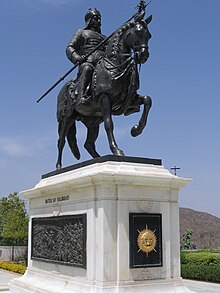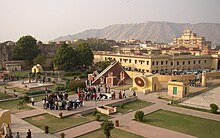
The history of human settlement in the western Indian state of Rajasthan dates back to about 100,000 years ago. Around 5000 to 2000 BCE many regions of Rajasthan belonged as the site of the Indus Valley Civilization. Kalibangan is the main Indus site of Rajasthan, here fire altars have been discovered, similar to those found at Lothal.[1]


Around 2000 BCE, Sarasvati River flowed through the Aravalli mountain range in the state. During the Vedic Period present Rajasthan region known as Brahmavarta (The land created by the gods and lying between the divine rivers Saraswati and Drishadwati). Matsya kingdom (c. 1500–350 BCE) was the one of the most important Vedic kingdom. The main ruler of kingdom was king Virata, who participated in Kurukshetra War by the side of Pandavas. After Vedic Period, Rajasthan was ruled by many Mahajanapadas includes- Matsya, Surasena, Kuru, Arjunayanas, Sivis and others.
The early medieval period saw the rise of many Rajput kingdoms such as the Chauhans of Ajmer, Sisodias of Mewar, Gurjara-Pratihara and the Rathores of Marwar, as well as several Rajput clans such as the Gohil and the Shekhawats of Shekhawati.[2] The Gurjara-Pratihara Empire acted as a barrier for Arab invaders from the 8th to the 11th century, it was the power of the Pratihara army that effectively barred the progress of the Arabs beyond the confines of Sindh, their only conquest for nearly 300 years.[3]
Prithviraj Chauhan led a coalition with Gaur royal dynasty of Sarwar who defeated the Ghurid army; the Gohils and Sisodia of Chittor, who continued to resist the Mughals against heavy odds eventually gave rise to the leadership of Maharana Hammir, Maharana Kumbha, Maharana Sanga, Maharana Pratap and Maharana Raj Singh.[4]
In his long military career, Maharana Sanga achieved a series of unbroken successes against several neighbouring Muslim kingdoms, most notably the Lodi dynasty of Delhi. He united several Rajput clans for the first time since the Second Battle of Tarain and marched against the Timurid ruler Babur.[5] Maharana Pratap in the 16th century, both men became a symbol of Rajput valour against the Mughal invasions.[6]
The other famous rulers of Rajasthan includes Maldeo Rathore of Marwar, Rai Singh of Bikaner and Kachhawa rulers of Jaipur include Man Singh I and Sawai Jai Singh. While Jat kingdoms rise in early modern period include the Johiya of Jangaldesh, the Sinsinwars of Bharatpur State, as well as the Bamraulia clan and the Ranas of Dholpur. Maharaja Suraj Mal was the greatest Jat ruler of Rajasthan.[7] Maharaja Ganga Singh of Bikaner State was the notable ruler of modern period. His greatest achievement was the completion of Gang Canal Project in 1927.[8]
Among many of Rajasthan's most important architectural works are the Jantar Mantar, Dilwara Temples, Lake Palace Resort, City Palace of Jaipur, City Palace of Udaipur, Chittorgarh Fort, Jaisalmer Havelis and Kumbhalgarh also known as the Great Wall of India.
The British made several treaties with rulers of Rajasthan and also made allies out of local rulers, who were allowed to rule their princely states. This period was marked by famines and economic exploitation. The Rajputana Agency was a political office of the British Indian Empire dealing with a collection of native states in Rajputana (present, Rajasthan).[9]
After Indian Independence in 1947, the various princely states of Rajputana were integrated in seven stages to formed present day state of Rajasthan on 1 November 1956.
- ^ Frontiers of the Indus Civilization
- ^ Gupta, Kunj Bihari Lal (1969). The Evolution of Administration of the Former Bharatpur State, 1722-1947. Vidya Bhawan. Archived from the original on 7 April 2023. Retrieved 29 January 2023.
- ^ Tod, James (1899). The Annals and Antiquities of Rajastʾhan: Or the Central and Western Rajpoot States of India. Indian Publication Society. Archived from the original on 7 April 2023. Retrieved 29 January 2023.
- ^ General, India Office of the Registrar (1975). Census of India, 1971: Series 1: India. Manager of Publications. Archived from the original on 7 April 2023. Retrieved 29 January 2023.
- ^ "Rajasthan Through the Ages Vol 1 Bakshi S. R."
- ^ Sarkar 1994, pp. 41–42.
- ^ Sen, Sailendra Nath (2010). An Advanced History of Modern India. Macmillan. p. 420. ISBN 978-0-230-32885-3.
- ^ Daniel Hillel (2016), Advances in Irrigation, Elsevier, p. 132, ISBN 978-1-4832-1527-3
- ^ Imperial Gazetteer of India, v. 16, p. 156.